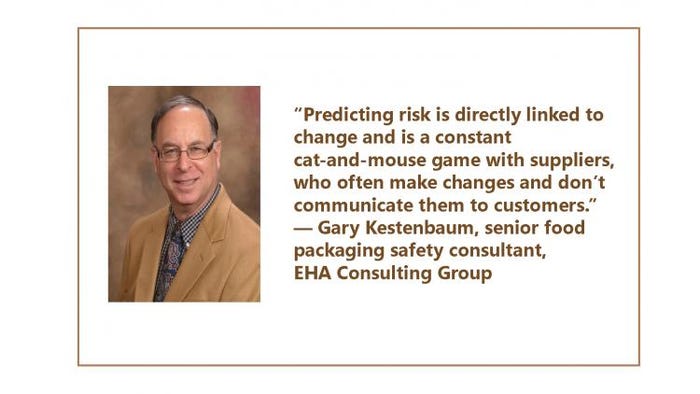August 8, 2017

Packaging Safety Expert Gary Kestenbaum offers 12 suggestions on how to adjust and improve risk oversight processes to keep prior risk from becoming future certainty.
My previous blog addressed changes in risk profile patters which, over time, may increase quality and safety risks to such an extent that they move from “risks” to “certainties” (see Food packaging safety: Avoiding '911' emergencies Part 1). The future rests not on what may occur, but, rather, when it will occur and when it does, how bad the exposure will impact your business.
When comprehensive risk and safety analyses are diligently performed and the concept of presumptive certainty of risks and hazards from intentional, unintentional, fraudulent, deceptive or inadequately controlled practices, internal and external, is considered, one will conclude that prevention and control require continuous assessment improvement and mitigation techniques. Reliance on outdated procedures based on obsolete input data and frequently changing conditions is the functional equivalent of putting ones head in the sand and hoping for the best. Decisions you make regarding what to purchase, from whom and where, or how/where to convert and test will impact the degree and extent of risk to food safety in the marketplace. As well, decisions not under your control, such as when a trusted, critical domestic supplier delivers the “going out of business” message, will also impact your existing food safety control system.
From a standpoint of process and formalities, there is little difference in the methods and protocols used to identify, consider, understand and quantify risks of harm and defects including:
• Non-conforming and defective incoming or outgoing products or materials;
• Fraudulent materials or sources of supply;
• Product tampering;
• Internal or external sabotage;
• Violative and unsuitable products, internal and external;
• Contaminated or adulterated products;
• Unreliable and inconsistent raw materials; and
• Supplier closure or abandonment of supply.
Each risk item or category, whether required by law, regulation or otherwise, needs to be assessed using a similar Q&A format for potential, frequency and extent. Mitigation and control details need to be determined by looking out of the box and adjusting the questions and answers to consider changing dynamics. If a threat or risk characteristic (such as, “how frequently can we expect products to be tampered with or sabotaged?”) gets assigned a “not enough data to predict” answer, there still must be a corresponding action list or next steps.
Like the floods or wildfires analogy, if experiences determine that calamity is not a question of “if,” but only a question of “when and how often,” difficult proactive decisions have to be made. Assume that if you’ve failed to consider a calamity type in your assessment procedure or if you must admit that you’ve considered it, but not implemented a functional plan to identify and control it, there will be little sympathy and understanding from regulatory authorities or harmed parties.
12 ideas to consider
As a plan, here are 12 process suggestions:
1. Create a cross-functional risk assessment/hazard analysis team.
2. Have that team bucket each analysis category based on regulatory necessity and functional applicability.
3. Begin with the obvious first, presumably HACCP or HARPC, whichever is applicable. In the package materials industry, the likely of the two is HARPC.
4. Obtain risk/harm analysis grid templates from a reputable, experienced, qualified industry or food safety oversight association resources. Execute the overall process based on the assumption that every touch point in the process from end-to-end will negatively affect safety and quality if not understood, managed, controlled and continuously audited for the “as-is” specifics.
5. Review the template for comprehensiveness and applicability. Customize and improve accordingly. Use generic and local terminology together, so as not to create misunderstandings.
6. Begin to gather data and information from internal and external sources to answer “what, who, how, where and under what limits and conditions.” Include a list of qualifying documents which specify and describe said specs, limits, requirements and controls.
7. Build an electronic file which contains the answers to each qualitative question in the grid. Begin with the manual of regulations, requirements, specifications, limits and conditions created by your cross-functional team of regulatory, tech/research, operations and marketing representatives, at the least.
8. Add folders which include data and documents from internal and external resources which you will need to populate each box in the grid. Query applicable resources when answers are erroneous, vague or omitted.
9. Review the “what,” the “when,” the “who/where,” the “how often” and, most importantly, the “extent of harm” when the risk/defect gets through to the marketplace.
10. Take the time to add answers for inconvenient truths and likelihoods. If the answers to boxed qualitative, such as “how likely is this (defect type) to occur”, in that the vendor has no track record with us or does not have lengthy experience converting these goods” is “too little data to predict”, then the worst must be assumed and corresponding methods must be recommended, regardless of expense and inconvenience.
11. Once the risks are qualified and quantified or assigned a “not able to answer or predict,” tackle the second phase of the process, adding corresponding oversight, mitigations and controls. Honest risk and extend MUST drive corresponding testing, product and information auditing frequency and process, oversights and observation, visual inspection, sensory and analytical analyses, performance specifications, redundancies, standard references, documentation and more.
This includes creating applicable audit and analysis protocols where none currently exist. The cornerstone of audit and analysis begins with a mathematically-defensible sampling plan, the honesty and accuracy of which is unquestionably documented. The same relates to the analysis. Until the audit and analysis process is deemed to have built enough data to predict suitability, safety, consistency and viability of supply, the process cannot and should not be relaxed.
Once the analysis and control processes have been completed, continue with a Food Defense assessment/analysis and mitigation plan and a Food Fraud assessment/analysis and mitigation plan.
12. Continue the processes until each risk, vulnerability, prevention and defense-related calamity has undergone the process.

The cat-and-mouse game with suppliers
Risk analyses in the food and packaging industries are much more accurate today than in years past, given the changes and upgrades to “the system.” Predicting risk is directly linked to change and is a constant cat-and-mouse game with suppliers, who often make changes and don’t communicate them to customers. All parties involved now have no excuse to claim ignorance of such behavior. FSMA and global norms demand involvement, attentiveness, continuous improvements and adjustments to insure the quality, safety and suitability of food and food packaging. To wit, each food packaging organization MUST audit specification information and data from existing suppliers. Do not assume that the supplier has communicated changes to the end products it ships you. Assume that they haven’t and question them semi-annually about changes to their raw materials, process and manufacturing locations. If a supplier changes WHERE your goods are converted, they have also changed HOW those goods are converted, because no two processes are identical.
What will happen to companies or facilities which suffer constant in-market calamities and related events? No process will tolerate continued failure. The driver with typical financial resources and a continuous record of motor vehicle convictions and accidents will eventually become uninsurable. Those who are uninsured or underinsured exist on the edge.
Suppliers and manufacturers will be forced into tough decisions. As with the owners of properties in flood-prone areas, they may have to increase prices as the cost and scope of risk mitigation increases. When the chain can no longer carry or offset costs related to rising materials safety risk, parties may have to consider the unpleasant alternative of abandonment.
Gary Kestenbaum has 40 years’ experience in the food and packaging industries, 6 as a supplier with National Starch, 18 as a product developer with General/Kraft Foods and 15 as a packaging engineer and developer with Kraft. As senior food packaging safety consultant with EHA Consulting Group, Kestenbaum provides guidance on packaging safety and suitability-related projects for raw material manufacturers, converters and associated supporting professionals. He can be reached at [email protected] or 410-484-9133. The website is www.ehagroup.com.
___________________________________________________________________________________
Looking for hot packaging ideas? Join the packaging experience during MinnPack in Minneapolis November 8-9 that’s part of a comprehensive all-in-one 6-event plastics and advanced manufacturing exhibition. For more information, visit MinnPack.
___________________________________________________________________________________
About the Author(s)
You May Also Like




